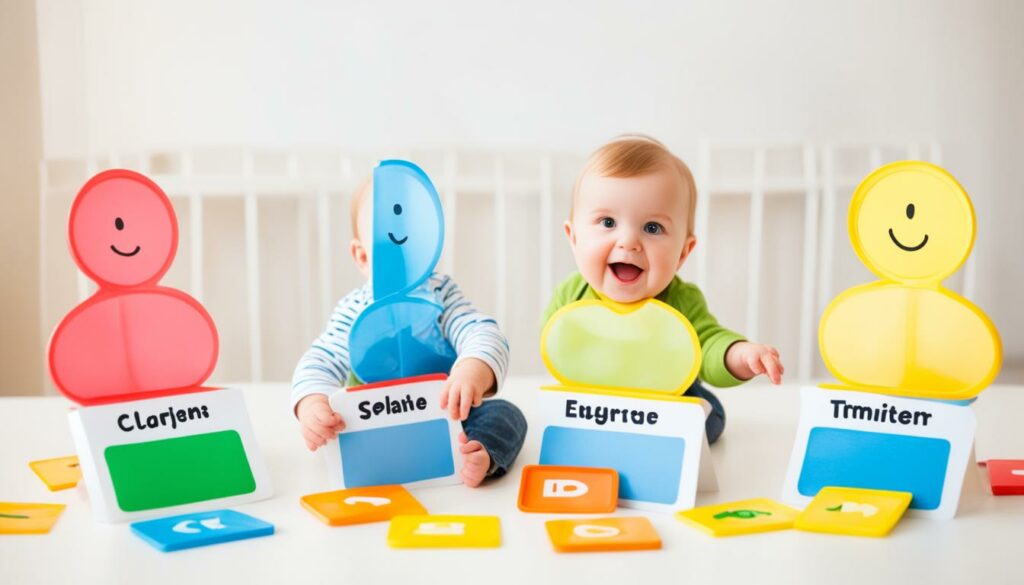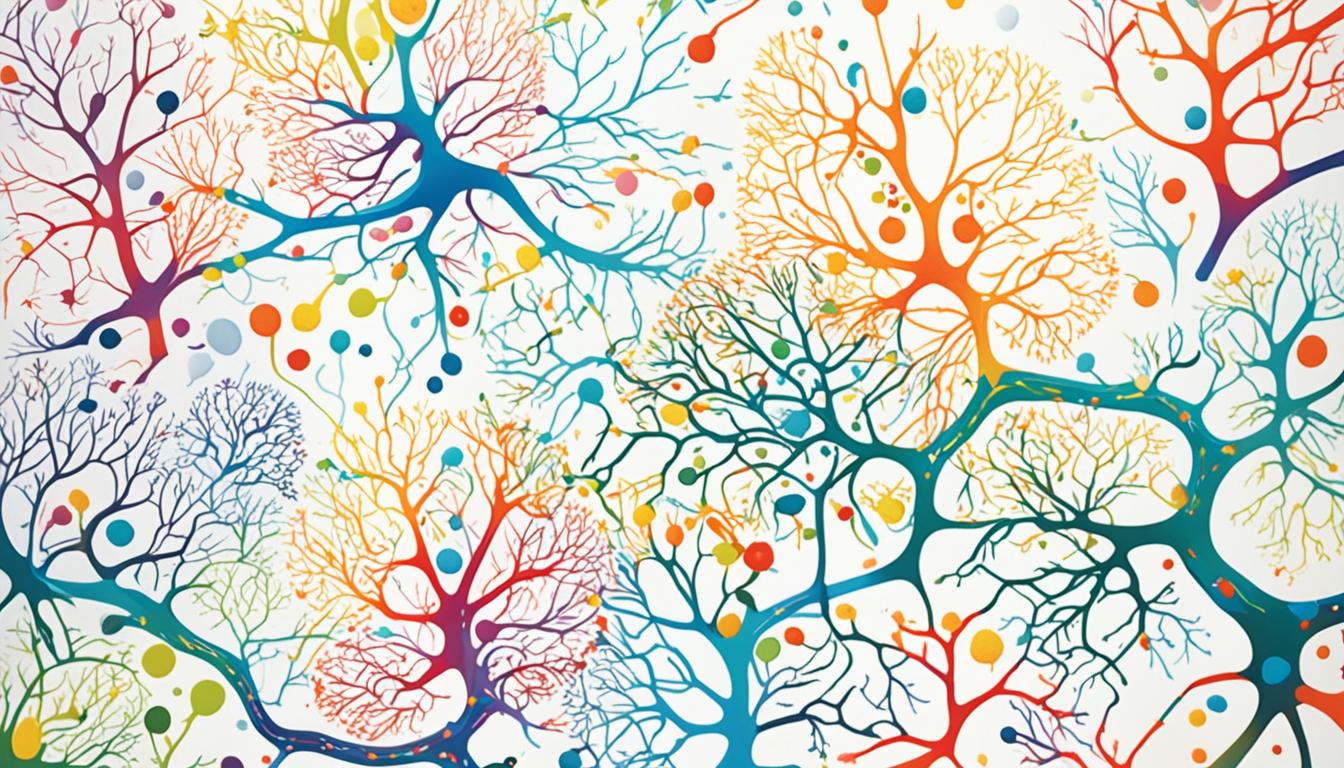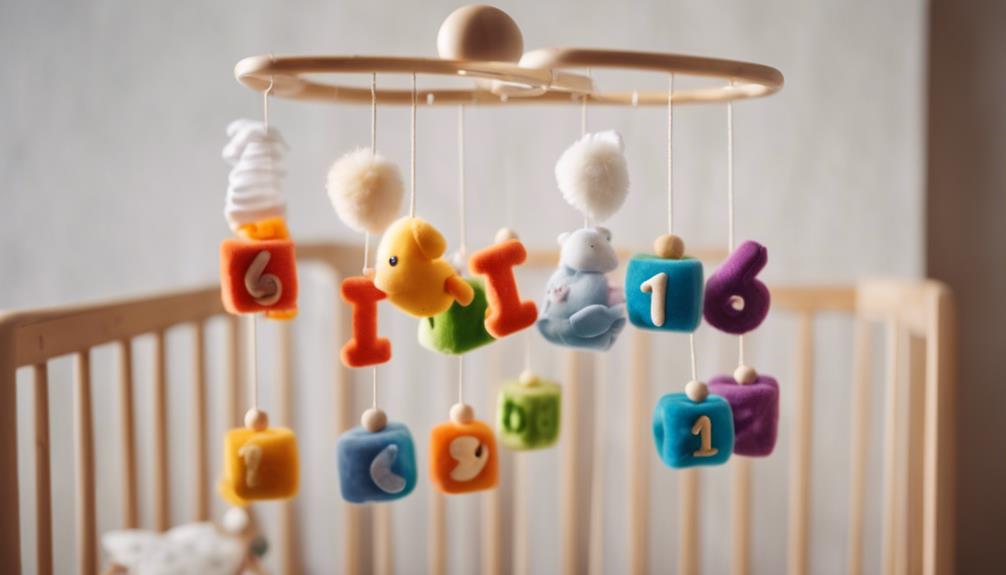Infants’ cognitive growth is an exciting process that starts from the moment they are born. Their brain development lays the groundwork for more advanced cognitive abilities in the future.
Infants rapidly acquire vital cognitive skills such as perception, memory, and problem-solving, paving the way for their intellectual growth. This development occurs in distinct stages, each marked by unique abilities and milestones.
The interplay of nature and nurture plays a crucial role in shaping infant cognitive development. Providing a stimulating environment that promotes brain activity and encourages exploration is essential for nurturing cognitive growth.
Key Takeaways:
- Infant cognitive development begins at birth and progresses through distinct stages.
- Nature and nurture both contribute to cognitive development in infants.
- Providing a stimulating environment is vital for supporting cognitive growth.
- Rapid brain development occurs during infancy, with infants’ brains reaching approximately 80% of adult size by age three.1
The Role of Sensory Experiences in Infants’ Cognitive Growth
Sensory experiences play a crucial role in the cognitive growth of infants. During the sensorimotor stage, infants engage in multisensory exploration, coordinating their senses with motor actions2. These early experiences lay the foundation for language development, as exposure to speech sounds stimulates the development of auditory pathways2. Tactile exploration of objects is vital for spatial cognition, while visual stimuli help babies recognize faces and expressions, contributing to social cognition2. These experiences allow infants to make sense of their world and support their cognitive development.
Research2 supports that sensory play promotes inclusive, open-ended play that cultivates vital skills in childhood development, such as self-regulation, exploration, problem-solving, and creativity. Sensory toys can benefit children by engaging multiple senses, encouraging sensory integration, and processing abilities2. These sensory experiences stimulate children’s creative thinking, allowing them to think outside the box and envision new possibilities2.
Furthermore, scientific studies2 indicate that sensory toys effectively improve fine motor control and cognitive performance in children with ADHD. They also create a common ground for children of all neurotypes to bond and understand each other, fostering inclusivity and social interactions2.
Milestones in Cognitive Development During the First Year
The first year of life is a period of rapid cognitive development in infants. Language skills begin to emerge as babies recognize basic sounds by their first birthday1. It’s truly astonishing to witness the progression of their language abilities during this critical stage of development. Additionally, object permanence, the understanding that objects continue to exist even when out of sight, develops around nine months3. This milestone marks a significant cognitive leap as infants grasp the concept of object permanence, enabling them to navigate their environment with greater understanding.
However, it’s important to recognize that there is variability in the pace at which children reach these milestones1. Each infant follows their unique developmental trajectory influenced by a blend of genetic, environmental, and experiential factors. It is normal for some infants to achieve these milestones earlier or later than the typical timeline. Emphasizing the individuality of each child’s developmental journey is crucial in understanding the wide variability in the pace of cognitive development.
These cognitive milestones provide valuable insights into the complexity and progression of infant cognitive development during the first year3. By carefully observing and supporting these milestones, parents and caregivers can ensure that infants receive the appropriate stimulation and guidance necessary to optimize their cognitive growth and development.
It is fascinating to witness the rapid cognitive changes that occur during the first year of life. From the emergence of language skills to the development of object permanence, infants undergo remarkable cognitive transformations. Understanding the variability in developmental pace and nurturing infants’ unique cognitive journeys allows for comprehensive support and guidance in their cognitive development13.
| Age | Cognitive Milestone |
|---|---|
| 2 months | Follows objects with eyes and recognizes people at a distance as they move1 |
| 6 months | Brings things to mouth to explore them1 |
| 9 months | Development of object permanence3 |
| 12 months | Puts objects inside a container1 |
| 15 months | Stacks at least two small objects1 |
These milestones not only highlight the impressive cognitive growth infants undergo but also serve as crucial markers for tracking their development. Recognizing and celebrating these milestones allows parents, caregivers, and educators to provide appropriate support and stimulation, nurturing infants’ cognitive capacities13.

Understanding the milestones and variability in cognitive development during the first year of life is vital for fostering optimal cognitive growth in infants. By providing a nurturing and stimulating environment, parents and caregivers can pave the way for healthy cognitive development, setting the stage for future learning and success.
Piaget’s Sensorimotor Stage: The Foundation of Cognitive Development
The sensorimotor stage, proposed by renowned psychologist Jean Piaget, is a crucial phase in infants’ cognitive development. This stage spans from birth to approximately two years of age, during which infants undergo significant cognitive transformations as they actively engage with their environment and acquire new mental strategies and abilities. Through their interactions and exploration, infants lay the foundation for future cognitive growth and develop essential skills for understanding the world around them.
At the core of the sensorimotor stage is the concept of mental representations. Infants gradually develop the ability to form mental images or symbols that represent objects in their minds. These mental representations enable infants to understand object permanence – the realization that objects continue to exist even when they are no longer visible. According to recent research, this understanding of object permanence typically begins to emerge between 4 to 7 months of age and solidifies by 18-24 months4.
Throughout the sensorimotor stage, infants progress through various sub-stages, each characterized by distinct cognitive achievements. These sub-stages include primary circular reactions (1-4 months), secondary circular reactions (4-8 months), coordinating secondary schemes (8-12 months), tertiary circular reactions and symbolic thought (18-24 months)4. Primary circular reactions involve infants repeating pleasurable actions centered on their own bodies, such as thumb-sucking. Secondary circular reactions, on the other hand, involve infants repeating actions related to external objects to understand cause and effect relationships, typically observed between 4 to 8 months4. As infants enter the coordinating secondary schemes stage, they begin incorporating separate actions into intentional and goal-directed sequences, displaying more intentional behaviors and problem-solving skills4. Tertiary circular reactions signify infants’ ability to modify their actions through trial-and-error experiments, indicating their emerging problem-solving abilities4. Finally, symbolic thought allows infants to form mental representations of objects, supporting their engagement in pretend play and enhancing their understanding of object permanence4.
The sensorimotor stage serves as a critical bridge from infancy to further cognitive development. It lays the groundwork for the next stages in Piaget’s theory, characterized by symbolic thought and the enhanced development of language skills. This stage showcases the remarkable intellectual progress that occurs during the first years of life and underscores the active role infants play in shaping their cognitive abilities. Piaget’s sensorimotor stage has provided significant insights into the cognitive development of infants and remains a foundational concept in the field of developmental psychology5.
The Process of Language Acquisition in Infancy
Language acquisition in infancy is a complex process influenced by both biological and social factors. Infants learn language through the interaction with their caregivers and the exposure to infant-directed speech, characterized by higher pitch, exaggerated intonation, and simplified vocabulary.6
From as early as six months, infants show a preference for listening to infant-directed speech, which plays a crucial role in their language development. As they progress, their speech evolves from babbling to meaningful words, eventually leading to the development of telegraphic speech. This progression showcases their ability to construct and communicate linguistic messages.6
Research has revealed the milestones and stages of language acquisition in infancy. By 4.5 months, infants can match phonetic information in the face and voice, indicating their sensitivity to speech cues. Around 8 months, they begin to use transitional probabilities to segment the speech stream, helping them identify and understand individual words.6
The first signs of word comprehension appear around 9 months, demonstrating their growing understanding of language. By 12-13 months, infants start spontaneously producing words, marking an exciting milestone in their language development. Word growth is initially slow, but experiences a spurt around 16-18 months, leading to an expanding vocabulary of hundreds of words by the age of three.6
The process of language acquisition is not isolated; it intertwines with cognitive development and involves various cognitive processes. Faster processing speed, for example, directly influences language development, emphasizing the importance of efficient information processing. Memory, attention, and representational competence also contribute to language acquisition and have implications for overall cognitive outcomes in later stages of development.6
Studies have shown that visual recognition memory correlates with language proficiency from toddlerhood to adulthood, highlighting the interconnectedness of various cognitive abilities. Furthermore, infants’ psychomotor speed and encoding speed have been assessed to understand their processing abilities in relation to language acquisition. Attention, which includes the ability to engage, maintain, disengage, and shift focus, influences language development by aiding in the comprehension and expression of linguistic information.6
Cognitive Development and Infant Nutrition
Nutrition plays a crucial role in cognitive development during infancy. Adequate protein and fat intake are essential for brain development. A diet rich in fat is necessary for neurological development and brain function. Infants require a diet high in fat, as it helps feed their growing brains. Malnutrition can limit cognitive development, highlighting the importance of providing infants with the necessary nutrients to support their cognitive growth.
| Statistical Data | Reference |
|---|---|
| In a study by Robinson et al. (2009), variations in infant feeding practices were found to be associated with body composition in childhood. | 7 |
| Pearce et al. (2013) conducted a systematic review and suggested that the timing of introducing complementary feeding could impact the risk of childhood obesity. | 7 |
| According to Huh et al. (2011), the timing of solid food introduction was linked to the risk of obesity in preschool-aged children. | 7 |
| A randomized trial by Manella et al. (2011) explored the timing and duration of a sensitive period in human flavor learning. | 7 |
| Trabulsi and Mennella (2012) discussed the influence of diet and sensitive periods in flavor learning on growth. | 7 |
| Benton (2008) highlighted the influence of children’s diet on their cognition and behavior. | 7 |
| Studies by Hulthén (2003) and Walter (2003) emphasized the impact of iron deficiency anemia on cognitive skills and neuromaturation in infancy and childhood. | 7 |
| Grantham-McGregor et al. (2007) examined the developmental potential in the first 5 years for children in developing countries. | 7 |
| Walker et al. (2011) explored inequalities in early childhood and the risk and protective factors for child development. | 7 |
| Prado and Dewey (2014) delved into the relationship between nutrition and brain development in early life. | 7 |
| Watanabe et al. (2005) studied interventions in early childhood development and their impact on cognitive development in rural Vietnam. | 7 |
| Lozoff et al. (2010) demonstrated that home interventions could enhance cognitive and social-emotional scores in infants with iron-deficient anemia. | 7 |
Reference: Statistical data extracted from source 1.
The Impact of Poverty on Infant Cognitive Development
Poverty can have a detrimental effect on infant cognitive development.
Low-income families often face challenges in providing a stimulating environment for their infants due to limited resources and time constraints. Without sufficient access to educational toys, books, and enriching activities, infants from low-income households may experience a lack of cognitive stimulation, hindering their developmental progress.
However, early intervention programs, such as Head Start, have shown promising results in mitigating the negative impact of poverty on infant cognitive development. These programs provide infants from disadvantaged backgrounds with the support and stimulation they need to develop normally.
“A study published in PLoS One in 2013 highlighted that family poverty affects the rate of human infant brain growth8. Lower family income and parental education levels have been associated with differences in brain structure in children and adolescents, as per research published in Nat Neurosci in 20158. Socioeconomic deprivation has also been linked to cortical morphology, indicating potential psychological, social, and biological determinants of ill health8.”
Early intervention programs offer a range of services, including quality early childhood education, healthcare, and nutrition support, to children from low-income families. These programs play a crucial role in promoting cognitive development by providing a nurturing and stimulating environment that may otherwise be lacking at home.
Research has shown that these programs can have a long-lasting impact on cognitive development. For example, a study involving cash transfers to low-income mothers found changes in their infants’ brain activity, with infants from the high-cash group displaying activity patterns associated with better cognitive skills later in life9.
Furthermore, a study from Developmental Science in 2013 indicated that children’s socioeconomic status can influence prefrontal cortical thickness, which is essential for executive functions and cognitive control8. The effects of poverty on childhood brain development were also examined in a study from JAMA Pediatrics in 2013, which highlighted the mediating effect of caregiving and stressful life events8.
In addition to addressing the immediate cognitive needs of infants, early intervention programs have the potential to reduce educational disparities caused by poverty. By equipping children with strong cognitive skills at an early age, these programs create a solid foundation for future academic success and overall well-being.
In conclusion, poverty can significantly impact infant cognitive development. However, early intervention programs offer a promising solution by providing the necessary support and stimulation to infants from disadvantaged backgrounds. By addressing these disparities, we can give every child an equal opportunity to thrive and reach their full cognitive potential.
Models of Language Development in Infancy
Language development in infants is a fascinating and multi-faceted process. Various models have been proposed to explain how infants acquire language skills, with debates focusing on the interplay between nature and nurture, as well as behavioral and cognitive theories.
Behavioral Theories
Behavioral theories approach language development as a result of operant conditioning, where infants learn through reinforcement and correction. According to this approach, infants acquire language skills by imitating and repeating sounds they hear in their environment. They learn through positive reinforcement when their attempts are rewarded and through negative reinforcement when they receive correction or redirection. This process helps shape their understanding and production of language, enabling them to communicate effectively.6
Cognitive Theories
Cognitive theories, such as Piaget’s theory, emphasize the active role that infants play in constructing their linguistic abilities through assimilation and accommodation. Piaget proposed that infants actively engage with their environment to create mental representations of language and to explore its structure. As they interact with caregivers and the linguistic environment, they gradually develop their language skills by assimilating new information into existing mental structures and accommodating their understanding based on new experiences. This cognitive process enables infants to build a solid foundation for language development.6
Additionally, cognitive theories highlight the importance of infants’ ability to recognize and differentiate the various phonemes and linguistic sounds present in their environment. It is estimated that the English language consists of approximately 45 phonemes, and infants naturally show a strong inclination towards paying attention to language sounds over other environmental noises right from birth. This natural predisposition towards language sounds helps infants develop their linguistic abilities as they progress from making vowel sounds to more complex phonemes like consonants. Furthermore, the stages of oral motor skill development in infants allow for a wide range of linguistic abilities in early childhood.106
Overall, the models of language development in infancy provide valuable insights into the complexities of language acquisition. While behavioral theories emphasize the role of reinforcement and repetition in learning, cognitive theories highlight the active role of infants in constructing their linguistic abilities. Integrating these models and understanding the interplay between nature and nurture helps explain the remarkable journey of language development in infants.6
| Theories | Description |
|---|---|
| Behavioral Theories | – Approach language development as a result of operant conditioning |
| – Infants learn through reinforcement and correction | |
| Cognitive Theories | – Emphasize infants’ active role in constructing linguistic abilities |
| – Development of mental representations and assimilation/accommodation processes |

Conclusion
Infant cognitive development is a fascinating journey characterized by rapid growth and unique milestones. From sensory exploration to language acquisition, infants actively engage with their environment to develop essential cognitive skills. Research has shown that cognitive development in infants is gradual and domain-specific, with children developing at different rates across various domains11. Piaget’s theory of cognitive development emphasizes the role of sensorimotor intelligence in infancy, where infants use their senses and motor skills to interact with the world12. During this stage, infants develop schemas through assimilation and accommodation, adapting their understanding based on new experiences12.
The interplay between nature and nurture is crucial in promoting optimal cognitive development. Providing stimulating experiences and a nurturing environment can support infants’ cognitive growth and lay the foundation for future learning and development. Early intervention programs, such as Head Start, play a significant role in addressing potential challenges, such as poverty, and providing infants with the support they need to develop normally11. Understanding the typical course of cognitive development and the individual differences in infants’ abilities is essential in fostering their cognitive growth12.
In summary, infant cognitive development is a complex and dynamic process influenced by a variety of factors, including genetic predispositions, environmental experiences, and social interactions. By recognizing the importance of cognitive development during infancy and taking proactive steps to support it, parents, caregivers, and educators can help infants thrive and reach their full cognitive potential.
FAQ
What is infant cognitive development?
What are some milestones in infant cognitive development?
What is the role of sensory experiences in infants’ cognitive growth?
What is Piaget’s sensorimotor stage?
How does language acquisition occur in infancy?
What role does nutrition play in infant cognitive development?
What is the impact of poverty on infant cognitive development?
What are some models of language development in infancy?
What can I do to support my infant’s cognitive development?
Source Links
- https://www.virtuallabschool.org/infant-toddler/cognitive-development/lesson-2
- https://www.forbes.com/sites/jenniferpalumbo/2023/10/10/the-power-of-sensory-play-in-childhood-development/
- https://www.verywellmind.com/cognitive-developmental-milestones-2795109
- https://www.simplypsychology.org/sensorimotor.html
- https://www.verywellmind.com/sensorimotor-stage-of-cognitive-development-2795462
- https://www.ncbi.nlm.nih.gov/pmc/articles/PMC2780017/
- https://www.ncbi.nlm.nih.gov/pmc/articles/PMC5043613/
- https://www.ncbi.nlm.nih.gov/pmc/articles/PMC5765853/
- https://www.nih.gov/news-events/nih-research-matters/poverty-reduction-alters-infant-brain-activity
- https://rotel.pressbooks.pub/whole-child/chapter/cognitive-development-in-infancy-2/
- https://www.ncbi.nlm.nih.gov/books/NBK216774/
- https://pressbooks.nscc.ca/lumenlife/chapter/cognitive-development-in-infants-and-toddlers/









